When I attend CES, I always enjoy visiting the RBH
Sound booth, because (1) they make a wide variety of speaker models, and (2)
they have exotic wood veneers in which the models can be supplied. Also,
they sound great, and I guess that is the most important thing.
At CES, 2004, RBH announced some new speakers,
including the subwoofer reviewed here, the MS-10.1. It follows on the
MS-8.1.
The Design
The MS-10.1 uses two 10" aluminum cone drivers, both
active. One is front-firing, and the other is on the bottom, for
downward-firing.
The front driver has a perforated metal grille,
while the bottom one has no cover. There are four feet permanently mounted
on the bottom of the enclosure. They are not very long feet, so you can
place the sub on a short pile rug, but don't put it on a deep plush pile
carpet, as the driver could impact the rug fibers.
You can see in the above photo that the MS-10.1 has
a port on the side. The port is 5" in diameter and has a foam plug. The plug
has a 1" hole in the center.
All designs that I have seen before, that use foam
plugs in the port, allow you to use them either with the plug inserted, or
with it removed. This changes the response, but lets you get a higher SPL if
that is your need. As you will see below, in the bench test section, I
tested the frequency response with the plug in, and with it out. However, I
found later that the port plug is supposed to stay in, never removed. So I
asked, "Why not just make the port 1" in diameter and do away with the plug
entirely?"
The reason for this is RBH's specific design, called
the "Tuned Aperiodic Vent", or TAV. The foam plug acts as a "membrane" that
has some give to it, and the hole in the plug allows some air to come out.
This configuration puts the design between a regular "ported" enclosure and
a "sealed" one.
TAV is supposed to let you have a smaller enclosure,
but still deliver deep bass, partially because it has two active smaller
drivers instead of one larger driver.
The design appears to deliver on its promises, as
you will see below.
The MS-10.1 has a 250 amplifier mounted on the back
of the enclosure. For an $800 subwoofer, it has everything. The toggle switches
in the top of the photo are for power-on and auto-power-on, and to let you
switch the crossover in or out of the circuit (this is becoming more and
more important as SSPs and receivers become more flexible in their bass
management settings).
Inputs are line-level RCA unbalanced left and right,
with corresponding RCA line-level out for daisy chaining to other subwoofers
(full-range signal, not high-passed). There is also a set of speaker-level
inputs and outputs, with the outputs high-passed at 100 Hz.
Phase is continuously adjustable from 00
to 1800. The crossover is adjustable from 50 Hz to 180 Hz. The
volume control is next to the crossover dial.
AC is non-grounded, with removable power cord.
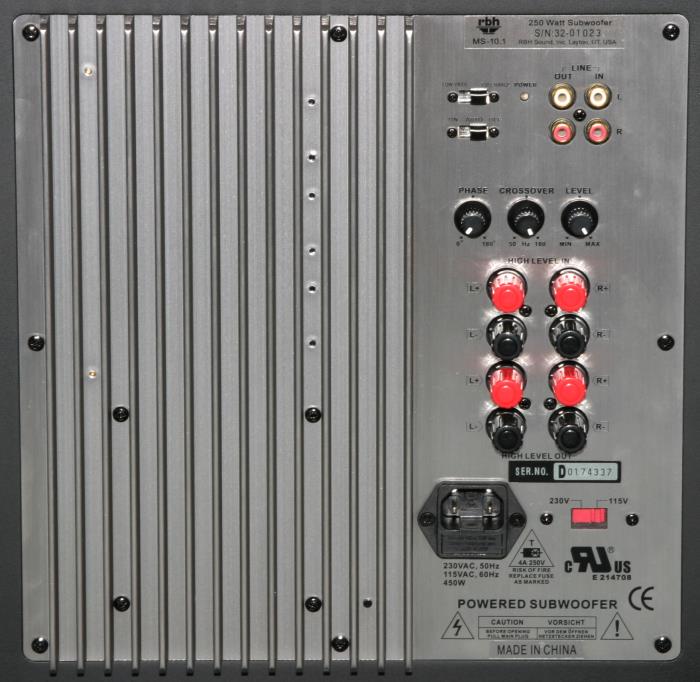
The Listening
I set the MS-10.1 up with our Yamaha Universal
Player, Lexicon MC-12, McIntosh Power Amplifiers, Balanced Audio Technology
Power Amplifiers, Carver Amazing Speakers, Thiel Speakers, and Nordost
Cables. I watched movies and listened to music, and the RBH courteously
supplied the bass.
Frankly, I was very surprised that the MS-10.1 could
keep up with this system, which is very big, and very
powerful. Although we review RBH products regularly, it has been a while
since I have personally reviewed them. It should remind me to get some RBH
more often.
 The
20 Hz stuff was really there! Now all subs will produce some sound with a 20
Hz signal. Even a car radio speaker will move a little bit. The question is
how much? The MS-10.1 delivered the goods, and I have a very critical ear
when it comes to deep bass. Sure, I could hear some harmonics when the RBH
was asked to do too much, but within reason, it did more than I expected it
to. It sounded clean and deep. I guess that odd-looking permanent foam plug
in the port is not just marketing hype.
The
20 Hz stuff was really there! Now all subs will produce some sound with a 20
Hz signal. Even a car radio speaker will move a little bit. The question is
how much? The MS-10.1 delivered the goods, and I have a very critical ear
when it comes to deep bass. Sure, I could hear some harmonics when the RBH
was asked to do too much, but within reason, it did more than I expected it
to. It sounded clean and deep. I guess that odd-looking permanent foam plug
in the port is not just marketing hype.
If I had not known the MSRP of this product, I would
have thought it was $1,400, because it sounds like some others I have heard
at that higher price.
On the Bench
The tests were performed with the foam plug in,
except for the frequency response comparison, as noted below. The crossover
was switched off (out of the circuit).
I measured 116 dB maximum output, 10" from the front
driver, using a single input signal that contained 20 Hz, 31.5 Hz, and 50 Hz
sine waves.
At 20 Hz, which is just below its rated response,
and 100 dB output (10" from the front driver), there was 22.3% THD.
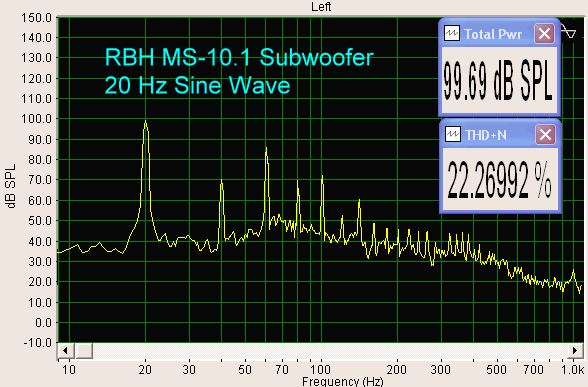
At 25 Hz, THD was reduced to 10.7%, a bit more
manageable, but still pretty high with a 100 dB output.
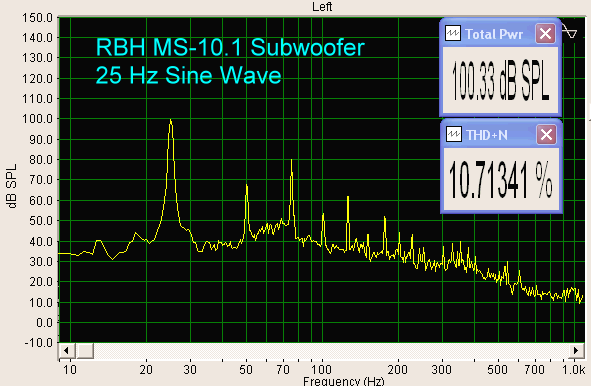
At 31.5 Hz, THD was a reasonable 3.1%, with 100 dB
output.
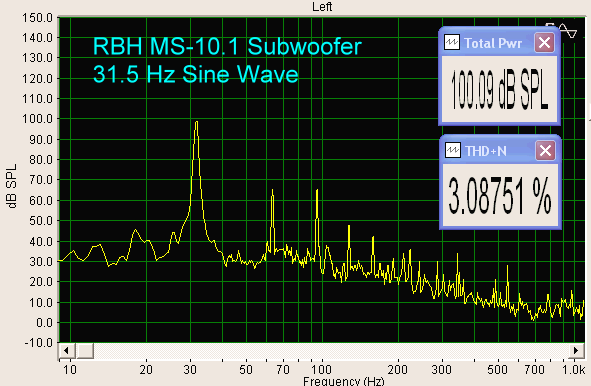
Going to 40 Hz, THD was a bit lower, at 2.5%.
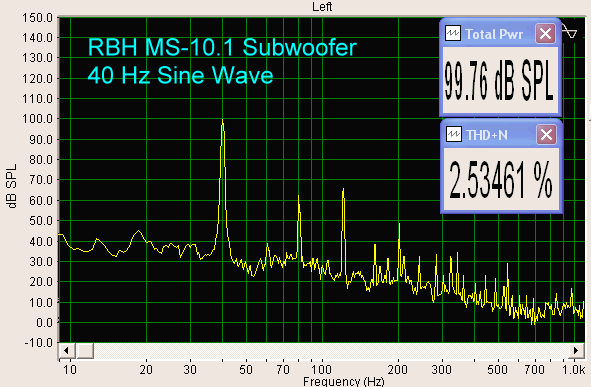
And, at 50 Hz, THD was well in control.
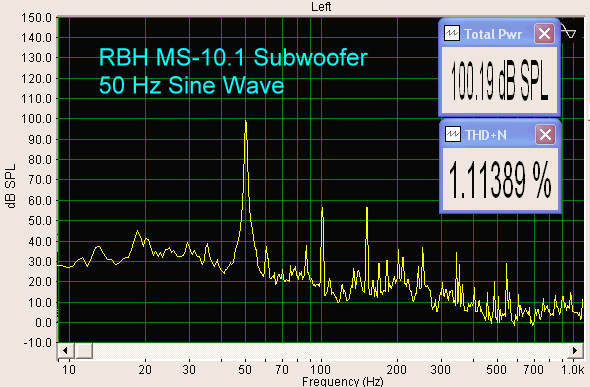
Although the port foam plug is not supposed to be removed, I
removed it anyway and measured the frequency response. It is not necessarily
relevant, but it shows some interesting results. Below is the response with
the plug in, as it is supposed to be. The peak is at 75 Hz, and rolls off 23
dB at 20 Hz. Notice how smooth the roll-off is. The MLS window is 50 ms.
Note that this is the quasi-anechoic response, not the room response.
The initial part of the impulse response is
negative, which means it is inverted. The phase adjustment dial does not affect this.
Some subs are electrically inverting, some are not. Same thing with
amplifiers. It seems like an electrical inverting toggle switch would be a
nice addition to subwoofers.
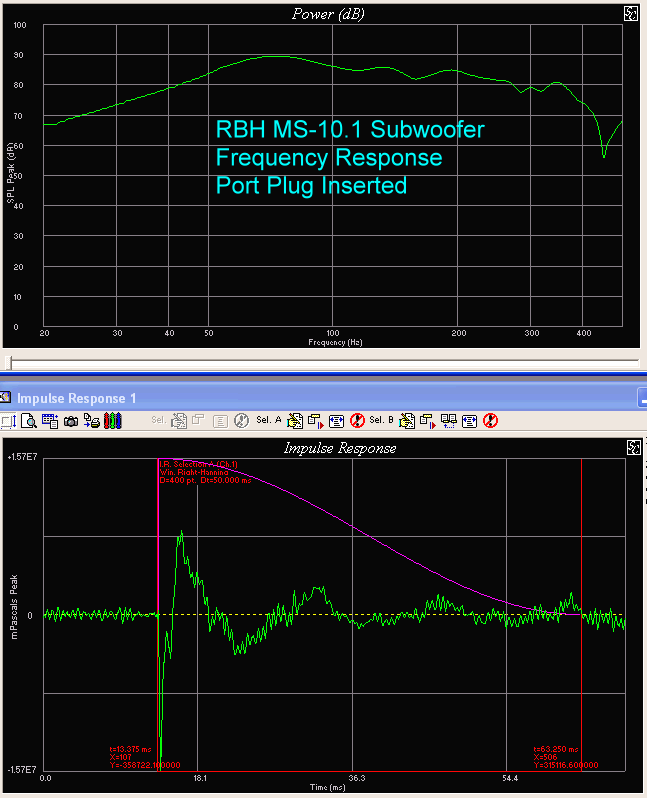
With the foam plug removed, the response is no
longer smooth. It rolls off more rapidly from 75 Hz to 40 Hz and then the
slope is shallower to 20 Hz. So, now you see how this foam plug "aperiodic
membrane" serves to improve the response.
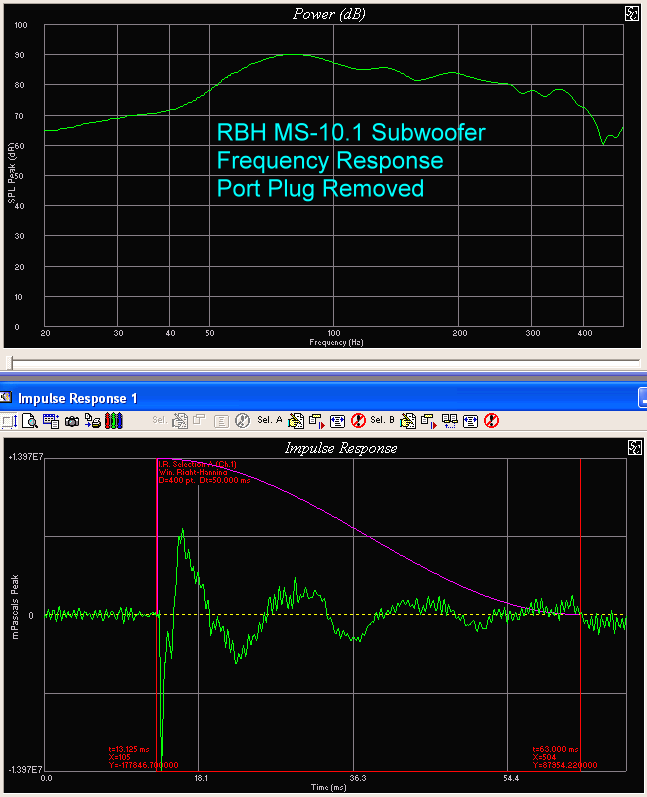
Conclusions
I am pleased to say that the RBH 10.1 is a very nice
product, especially at $800. It does a great job of delivering deep bass in
a reasonably sized enclosure. It has connection flexibility and features of
more expensive subwoofers. I have no reservations about recommending it
highly.
- John E. Johnson, Jr. -